Related Research Articles

The Rijksmuseum is the national museum of the Netherlands dedicated to Dutch arts and history and is located in Amsterdam. The museum is located at the Museum Square in the borough of Amsterdam South, close to the Van Gogh Museum, the Stedelijk Museum Amsterdam, and the Concertgebouw.

Theodorus van Gogh was a Dutch art dealer, the younger brother of Vincent van Gogh. Theo's unfailing financial and emotional support allowed his brother to devote himself entirely to painting. Theo died at the age of 33, six months after his brother died at the age of 37. At his death Theo owned practically all of his brother's artwork. Theo's widow Johanna van Gogh-Bonger worked tirelessly to promote the work of Vincent and keep the memory of her husband alive. Theo made a significant impact on the art world as an art dealer, playing a crucial role in the introduction of contemporary French art to the public. His widow was able to draw on the connections that Theo made to promote Vincent's work. In 1914, she reburied Theo's remains next to Vincent's.

Rembrandt Harmenszoon van Rijn, usually simply known as Rembrandt, was a Dutch Golden Age painter, printmaker, and draughtsman. An innovative and prolific master in three media, he is generally considered one of the greatest visual artists in the history of art. It is estimated Rembrandt produced a total of about three hundred paintings, three hundred etchings, and two thousand drawings.
Ernst van de Wetering was a Dutch art historian and an expert on Rembrandt and his work.
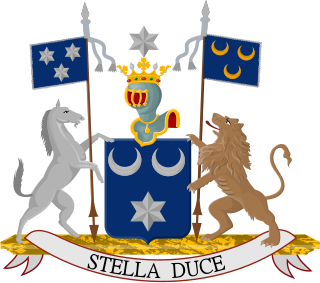
Six is a well-known Dutch family from Amsterdam. The family originally came from the region of Lille in the north of France.
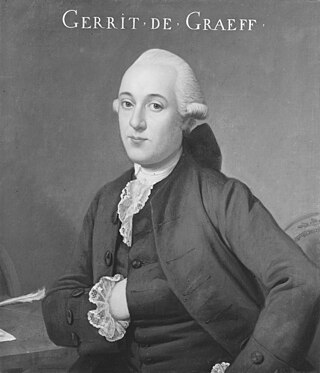
Gerrit de Graeff belonged to the patrician class of Amsterdam and held the feudal titles Free Lord of Zuid-Polsbroek as those of 21st Purmerland and Ilpendam. Known for his wealth and notorious for his stinginess, De Graeff was not particularly popular.
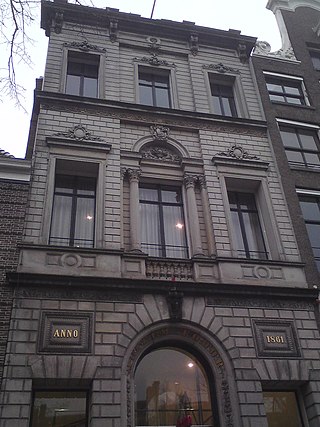
Foam or Fotografiemuseum Amsterdam is a photography museum located at the Keizersgracht in Amsterdam, the Netherlands. The museum has four different exhibitions at any given time in which different photographic genres are shown, such as documentary, art and fashion. Next to large exhibitions by well-known photographers, Foam also shows the work of young and upcoming photographers, in shorter running exhibitions.
Thomas Scott Kaplan is an American businessman, philanthropist and art collector. He is the world's largest private collector of Rembrandt's works.
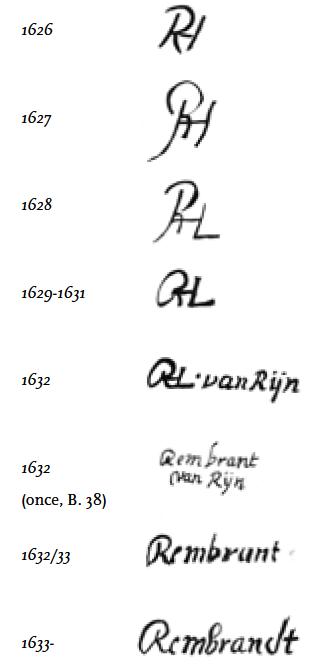
The Rembrandt Research Project (RRP) was an initiative of the Nederlandse Organisatie voor Wetenschappelijk Onderzoek (NWO), which is the Netherlands Organization for Scientific Research. Its purpose was to organize and categorize research on Rembrandt van Rijn, with the aim of discovering new facts about this Dutch Golden Age painter and his studio. The project started in 1968 and was sponsored by NWO until 1998. Research continued until 2014. It was the authority on Rembrandt and had the final say in whether a painting is genuine. The documentation generated by the project was transferred to the Netherlands Institute for Art History and renamed the Rembrandt Database.

The Portrait of Dirck van Os is a later painting by Rembrandt (1606–1669), created circa 1658. It is currently in the permanent collection of the Joslyn Art Museum in Omaha, Nebraska.

The Portrait of an African Man also known as Portrait of a Moor is a painting by the Dutch Renaissance painter Jan Mostaert. Mostaert probably made the painting between c. 1525 and 1530, or slightly earlier. The exact subject of the painting has long been unclear, although numerous ideas have been put forward, including that the depicted figure is a soldier, a nobleman or Saint Maurice. The portrait is significant in that it may portray the earliest surviving portrait of a specific black man in European painting, though Saint Maurice, and Balthazar of the Three Kings or Biblical Magi, had long been usually portrayed as Africans.

The Serenade is a 1629 oil painting by Judith Leyster in the collection of the Rijksmuseum. It was attributed for centuries to Frans Hals until Wilhelm von Bode saw it in the Six collection in 1883. He noticed the prominent "J" in the signature, and attributed it to Jan Hals. This is one of seven paintings first properly attributed to Leyster by Hofstede de Groot ten years later in 1893.

Portrait of Jan Six is a 1654 oil-on-canvas painting by the Dutch painter Rembrandt van Rijn. Having been handed down many generations, via the direct descendants of the portrait's subject, Jan Six, the work remains in the Six Collection in Amsterdam.
Daniël (Daan) van Golden was a Dutch artist, who has been active as a painter, photographer, collagist, installation artist, wall painter and graphic artist. He is known for his meticulous paintings of motives and details of everyday life and every day images.

Portrait of Catharina Hooghsaet (1607–1685) is a 1657 painting by the Dutch Golden Age painter Rembrandt.
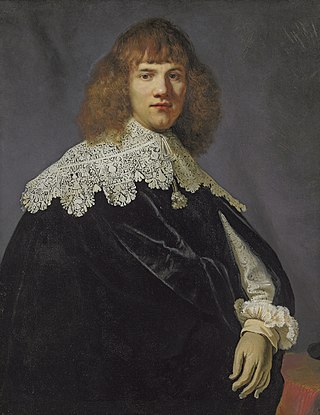
Portrait of a Young Gentleman is a c. 1635 painting attributed to the Dutch painter Rembrandt. The painting has not yet been catalogued as by Rembrandt, but was sold as "circle of Rembrandt" by Christie's in London for GBP 137,000.

Suffer little children to come unto me or Let the Little Children Come to Me, is a painting attributed to the Dutch painter Rembrandt. The subject of the portrait is the teaching of Jesus about little children and it is estimated that Rembrandt painted it in Leiden in the 1620s.
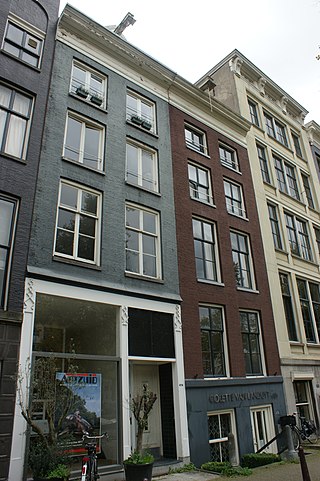
Galley Swart is a former Dutch gallery of Riekje Swart in Amsterdam from 1964 to 2000. The gallery promoted contemporary art of varies young art movements, and primarily wanted to arise interest for modern art.
Hendricus "Dick" Dankers was a Dutch furniture designer, and founder and gallery owner of The Frozen Fountain on the Prinsengracht in Amsterdam. He is remembered as "the man who brought the Netherlands to design."

The Preacher Eleazar Swalmius is a 1637 oil-on-canvas painting by the Dutch artist Rembrandt. It is currently owned by the Royal Museum of Fine Arts in Antwerp. The painting has been certified a real Rembrandt. The painting was listed in 1727 in the catalog of the Duke of Orléans collection, as a portrait of an Amsterdam mayor by Rembrandt. It remained in the noble family's possession until 1792, when Duke Louis-Philippe-Joseph sold the entire collection to finance his political career and pay off debts. The painting passed through several English collections into the hands of the Bourgeois brothers, art dealers from Cologne, who sold the painting as an original Rembrandt to the museum in 1886. The painting was stored away for a long time due to doubts cast over its authenticity.
References
- 1 2 Shorto, Russell (27 February 2019). "Rembrandt in the Blood: An Obsessive Aristocrat, Rediscovered Paintings and an Art-World Feud". The New York Times . Retrieved 2 October 2022.
- 1 2 3 4 Faber, Johan (17 September 2011). "'Ik werk nooit meer voor een groot bedrijf'". NRC (in Dutch). Retrieved 2018-05-21.
- 1 2 Ribbens, Arjen (15 May 2018). "'In één oogopslag zag ik: dit is een Rembrandt'". NRC (in Dutch). Retrieved 2018-05-21.
- 1 2 "A life with Old Masters". Financial Times. 20 March 2010. Retrieved 2018-05-21.
- ↑ "Kunsthandelaar Jan Six ontdekt 'nieuwe' Rembrandt - Amsterdam - PAROOL". Het Parool (in Dutch). 15 May 2018. Retrieved 2018-05-21.
- ↑ Pinedo, Danielle; Ribbens, Arjen (May 15, 2018). "Onbekend schilderij van Rembrandt ontdekt". NRC (in Dutch). Retrieved May 18, 2018.
- ↑ Siegal, Nina (May 16, 2018). "A New Rembrandt? A Dutch Art Dealer Says He's Found One". The New York Times. Retrieved May 18, 2018.
- ↑ Rea, Naomi (May 16, 2018). "An Art Dealer Claims He's Discovered a Previously Unknown Rembrandt. Where'd He Find It? At Christie's". Artnet News. Retrieved May 18, 2018.
- ↑ Meijer, Bart (May 16, 2018). "Dutch art dealer discovers first 'new' Rembrandt in 44 years". Reuters. Retrieved May 18, 2018.
- ↑ Katz, Brigit (May 17, 2018). "A Dutch Art Dealer Says He Discovered a New Rembrandt". Smithsonian. Retrieved May 18, 2018.
- ↑ Corder, Mike (May 16, 2018). "Painting newly attributed to Rembrandt on show in Amsterdam". Associated Press. Retrieved May 18, 2018.
- ↑ "First New Rembrandt in 44 Years on Show in Amsterdam". Financial Tribune. May 19, 2018. Retrieved May 18, 2018.
- ↑ "Portrait of a Young Gentleman is the first undiscovered Rembrandt in 44 years". DutchNews. May 15, 2018. Retrieved May 18, 2018.